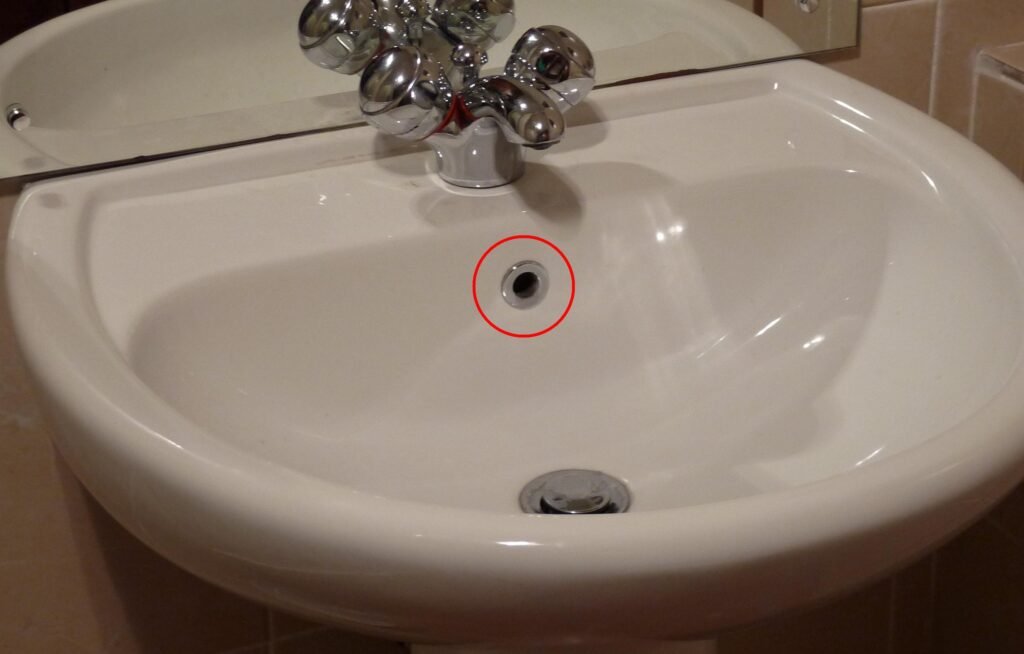In most cases, a sink overflow is directed into a concealed channel that runs anywhere along the underside of a sink basin. In many cases, it is not visible from either the sink’s top or bottom. Either two holes will be located near the top of an overflow channel. The water drains out of the channel and into the drain beneath the basin through a hole in its base. The water from the basin and the overflow goes down the same drainage pipe. However, the overflow is not controlled by the sink stopper and is always open.
Functions of a Sink Overflow Hole
An overflow hole, in general, has two main functions on your sink:
It prevents water from overflowing
If you plug up your bathroom sink‘s drain and fill the basin with water, it will begin to leak through the overflow hole and into the main drain. Sink overflow holes help keep water from overflowing the basin, but their limited size may not be effective against a particularly large volume of water. The overflow tube may temporarily prevent water from overflowing if the faucet is used at total capacity. One widespread misunderstanding would be that the sink overflow would catch any water that could spill out if the drain became clogged.

The drain opening inside the basin is usually close to the overflow outlet. Therefore, it’s improbable that a clog would block the drain but leave the overflow unimpeded. Any bathroom sink overflow prevents water from overflowing if the stopper is in place and the water supply is left running accidentally. Bathtub overflow drains are constructed differently, with extra space between the drain’s entrance and the overflow connector. Even if there is a clog near the drain entrance of the tub, the overflow spout can keep the water level from rising too high.
It greatly improves drainage
Another function is enabling air to enter the drain pipe through the overflow channel; the sink’s overflow helps your basin drain more quickly. When the water level in the basin rises to cover a drain opening entirely, a suction force is created that slows the rate at which water drains away. The suction force is diminished, and the water drains quicker thanks to the overflow providing air toward the drain pipe. Sinks without overflow holes often bubble as they drain and take longer to empty.
How to Clean a Sink Overflow Hole
Keeping a sink overflow clean and clear of debris is essential for its continued functionality. Water and air passage may be impeded by debris that collects at the overflow channel’s base. The overflow channel is cleaned infrequently because water only flows through it when the sink is full. Manually clearing the overflow and maintaining efficient sink drainage can be done in numerous ways:

1. Try a rubber hose
Put water in the sink until it reaches the overflow hole’s top. The overflow should be allowed to drain part of the water. Blow multiple puffs of air from the other end of a rubber hose while pressing one end against the overflow hole.
Empty the sink and re-inflate the line with compressed air. There shouldn’t be any obstructions for the air to flow through. This process can be repeated as many as necessary. Any durable hose you can slip over the overflow hole will do; however, a 7/8-inch hose from a dishwasher is ideal.
2. Using a Liquid cleaner
Combine fifty percent chlorine bleach with fifty percent plain water in a container with just a pour spout, and then pour the solution down the overflow holes. Once the mixture has settled, flush it with regular water for ten minutes.
3. Use a zip tie
Long plastic zip ties work best because of their flexibility and rigidity. They can easily follow the contours of the sink without bending. The overflow hole can be closed by inserting the pointed end of said zip tie further into the hole and working it deeper as far as possible. Work the zip tie in a vertical and horizontal motion to remove an obstruction. A longer zip tie will make it less likely that you’ll accidentally let it fall into the overflow tube.
Final Thoughts
An overflow hole is an essential part of a sink; without it, water will begin to overflow if the sink is plugged up. Overflow holes have limits on how much they can gather, so be mindful of how much volume of water your sink has. Cleaning an overflow hole can drastically improve its draining function as well.

